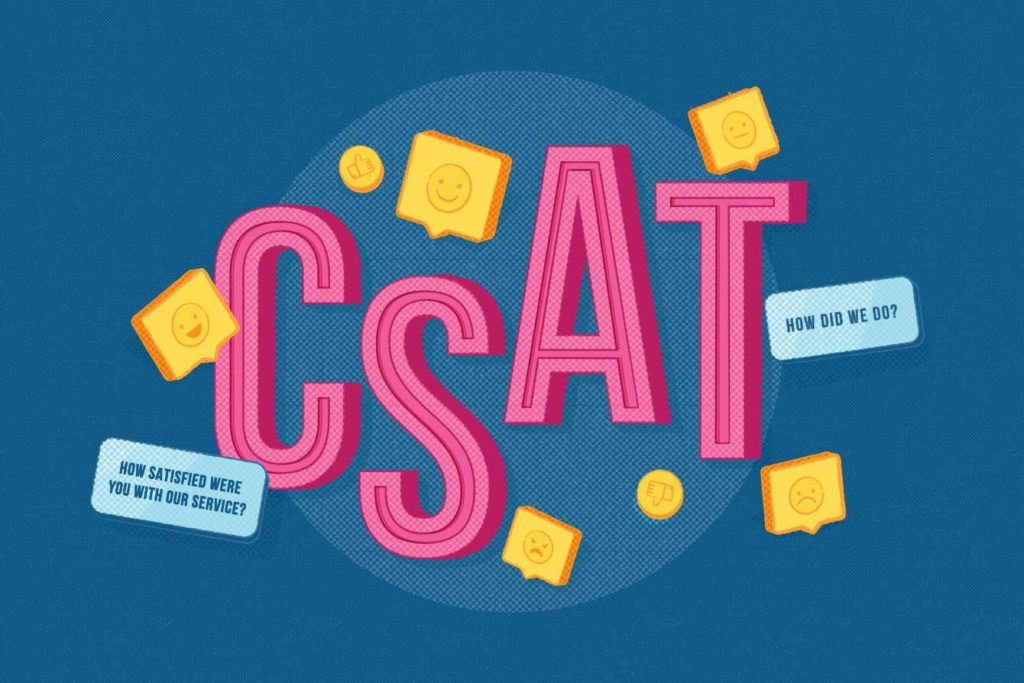You’ve probably heard the old cliché that the customer is always right. And you’ve probably heard it many times. That’s because the customer is always right, even when they’re wrong. Why? Because in any business, if you don’t have happy, satisfied customers, it’s almost guaranteed that your competition will.
Determining how satisfied your customers are requires you to dive deep into different metrics. Needless to say, it can be confusing! Which metrics are the most important? Which should you use extensively? And which can you put on the back burner? What metrics will help you determine how your company will satisfy its customers?
So let’s tackle the most important question: What is CSAT? CSAT (customer satisfaction) measures how satisfied a customer is with your product or service. As you know, customer satisfaction can make or break a business. Here, we’ll discuss some of the metrics you should be paying attention to when determining if your customers are satisfied.
What is CSAT?
Customer satisfaction sounds abstract, but it has a very specific definition in the world of customer service. CSAT measures how satisfied a customer is with your product or service, and it’s one of the most important drivers of revenue because it gauges the emotional impact of your interaction with a customer. It can also affect your bottom line if ignored—73% of customers say their experience with a company drives their loyalty to a brand.
Customer satisfaction can be measured by many different factors, the most common method being surveys. If a customer is satisfied and remembers their interaction with your company in a positive way, it can increase sales and revenue exponentially—84% of companies with improved customer service see an increase in revenue.
Conversely, if your company has a negative customer satisfaction experience, it will be remembered for much longer than a positive experience—far after the negative experience may have been remedied.
Costco has long offered an almost 100% return rate for some merchandise, even for perishable goods (unheard of in the grocery industry). There’s a well-known story of a man that returned a jar of salsa that was clearly three-quarters consumed or discarded. He walked up to the returns counter, they scanned the jar, and his account was refunded for the full price. It may lead to short-term losses, but in the end, customer interaction about this return policy is extremely positive, landing Costco No. 4 on AARP’s “10 Retailers With the Best Return Policies” list.
The different metrics for customer satisfaction
There are three distinct and commonly used metrics for determining customer satisfaction:
1. CSAT
The Customer Satisfaction Score mainly focuses on customer satisfaction with a business, purchase, or interaction. You send out a simple survey with short questions like, “How would you rate your experience with our product?” You then ask for ratings based on a scale (usually one to five, with one being the lowest point and five being the highest point). Take the numbers from the two highest ratings (fours and fives) and divide that by 100. The number equated is your CSAT score.
A high CSAT score lets you generally know where your strengths are. For instance, a high CSAT score means your customers are satisfied or highly satisfied with your business or product, which sales can then use to generate more revenue. Or, you could take a low CSAT score and determine where your weaknesses are (e.g. customers hate the call center hold times) and build on that for future growth.
The CSAT score is the broadest of the three scores used to measure customer satisfaction because it gives an overall picture of customer satisfaction. But it does not answer why a customer is satisfied or whether a customer will come back.
2. NPS
The Net Promoter Score (NPS) measures whether a respondent would recommend your company to someone else. It represents the loyalty of customers to your brand. Typical NPS questions are, “How likely are you to recommend this company (or product or service) to a friend (or coworker or family member)?” on a scale of 1 to 10.
There’s less interpretation when using NPS scores because the answers are usually cut and dry—do you like us or not? Would you recommend us or not?
3. CES
The Customer Effort Score (or CES) measures how easy or difficult it is for customers to engage with your business to get a problem solved. A common question is, “Did the representative make it easy for you to resolve your issue?” and is usually asked right after a customer purchases or uses a product or service. This will usually indicate whether your CX (customer experience) team handles interactions appropriately, but it won’t measure overall satisfaction with a brand or whether the customer would stay with the brand.
If a customer found the interaction with your company to be quick and easy, however, it is not an indication that the customer will be loyal to your brand or that they even like your product, which is why this should be used in conjunction with other metrics.
Why should you use CSAT in your business strategy?
Customer satisfaction is often a huge part of a company’s strategy, and rightfully so. Without a satisfied customer, you risk churn (i.e. losing your customers).
Even with less egregious customer experiences, you risk customers perceiving you as a company to avoid. This kind of reputational downgrade could be far more damaging—and last a lot longer—than simply one customer having a bad day.
Customer satisfaction paves the road for long- and short-term strategy.
You can use customer satisfaction to determine a lot of factors in your CX strategy. For example, a customer complaining about one issue should be a concern, but 100 customers complaining about the same issue should be a strategy shift. Where you make changes, and when you make changes, will rely on your customer feedback.
Say your most-answered response to the CSAT survey question “Were you satisfied with your wait time for a response?” was overwhelmingly negative. You can use that feedback to make an immediate reactive decision, like changing your response hours, or using a service like Mindful’s callback technology to reach customers when and how they choose, eliminating the very concept of wait time.
You could also take all three scores, which might show long wait times, little brand loyalty, and general customer dissatisfaction, then make proactive shifts to your company’s overall strategy. These could be changes such as the way that the product or service is offered or delivered. Using the scores in conjunction with each other will allow you to craft a more effective strategy than using them individually.
Customer satisfaction data allows you to pivot strategy quickly and plan resources accordingly.
When using customer satisfaction metrics, it should be immediately clear where the problems with your product or service might lie. Using customer satisfaction metrics highlights immediate gaps in your team resources, like a poorly trained or understaffed CX department.
These metrics would also help sustain an argument to management when looking to increase those resources for long-term customer satisfaction. Use customer satisfaction metrics to craft the conversations that might add people to your team, add new teams to your project, or even ask for a raise.
Combine CSAT to understand your customer.
It’s always considered a best practice to use a combination of CSAT, NPS, and CES together. When integrated with less measured factors like social media (54% of social media users use social media to research products, and 37% visit a brand’s social media page), it can help determine your customer’s mindset. This will help define the next steps in your company’s strategy.
Using customer satisfaction metrics individually could give you an incomplete picture of your customer, leading to poor decision-making.
Summing up
To help strengthen your customer satisfaction metrics, Mindful can create an overwhelmingly positive experience with callback, which gets customers off hold by letting them request a call at a time of their choosing. It can then connect the customer with automated notifications which confirm call times and remind customers when a call is coming up—a truly high-touch outcome with minimal effort.
Customer satisfaction is not a one-trick pony—it takes a combination of factors to get a fuller, more substantial snapshot of your customer.






